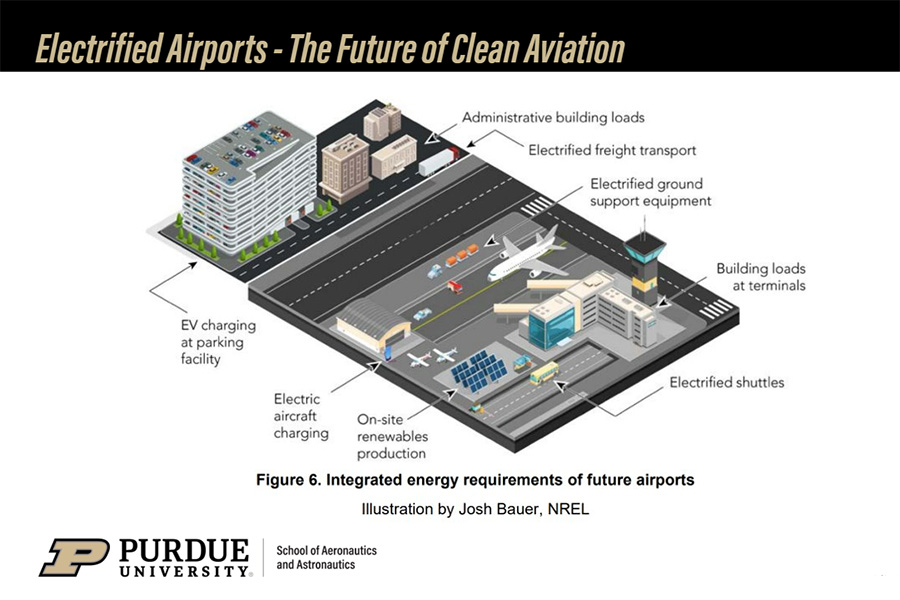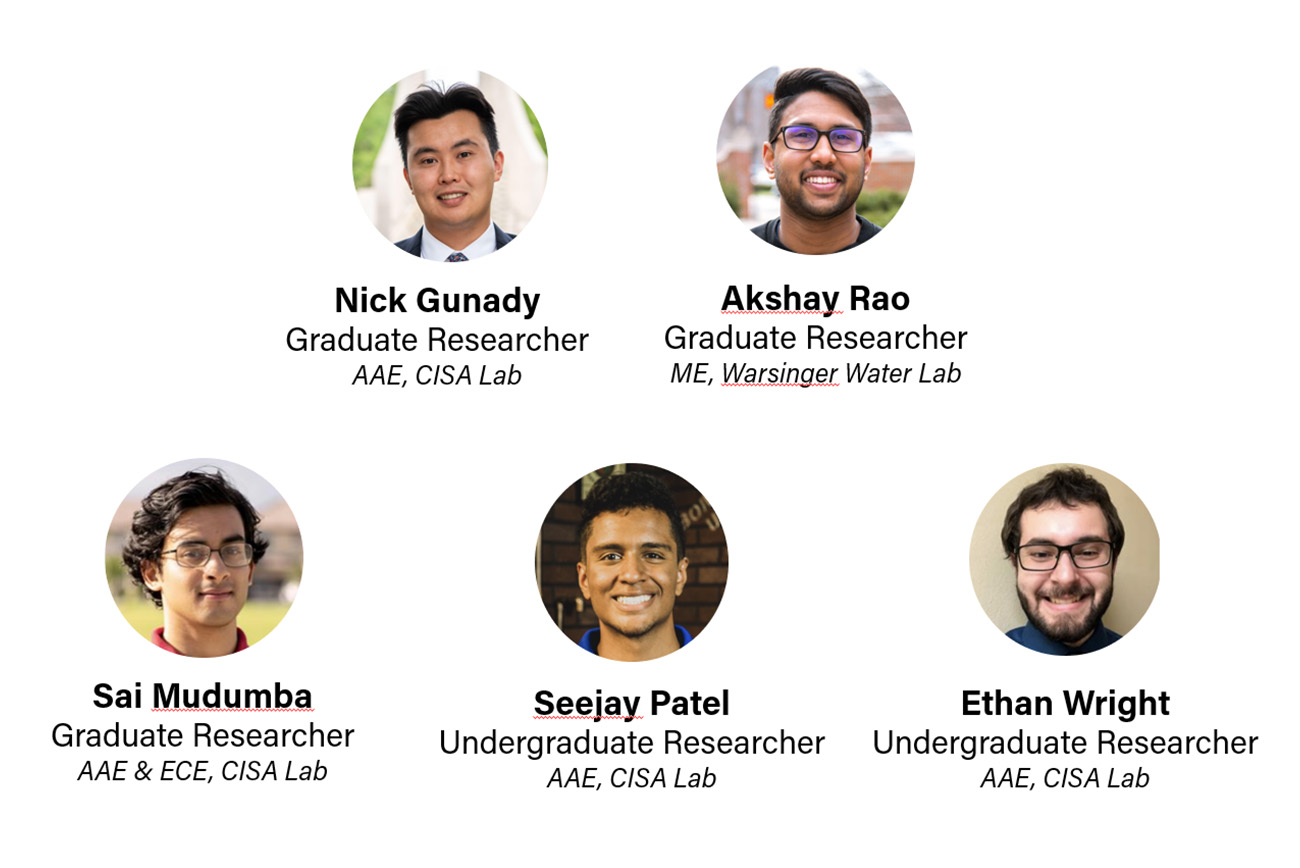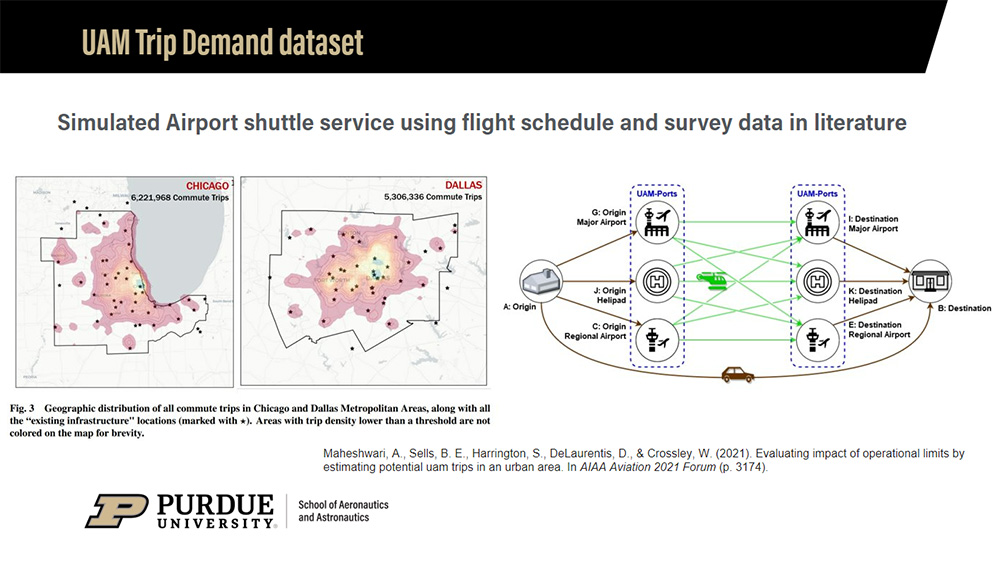Student Team Wins FAA Competition by Tackling Power Needs in Electrified Aviation

A team of five Purdue engineering students won this year’s FAA Challenge by demonstrating how a successful air taxi service will need to manage their electricity needs. They showed how balancing the use of renewable energy and the electricity grid will be necessary as Urban Air Mobility (UAM) vehicles enter into regular service, and developed sophisticated software to optimized power usage. The team won both their category and the overall win in the competition, taking home a total $25,000 cash prize.
The problem they were looking to solve, says team leader Nick Gunady, is that the United States electrical grid is not ready for widespread use of electric vehicles in any form. Gunady is a graduate student in Aeronautics and Astronautics (AAE) at Purdue and a research assistant at Purdue’s Center for Integrated Systems in Aerospace (CISA).
“We have advisors from NASA who have told us that at a certain point, urban air mobility has the ability to cause long-term damage to the grid because they'll be so many electric vehicles that we're plugging in at the same time. Our infrastructure can't handle that,” Gunady says. “So we've come up with a concept to reduce the dependence of future UAM operators on the grid.”

Their presentation is concerned with leveling the energy spikes related to charging these battery-powered vehicles after rush-hour use. The study’s analysis shows that current infrastructure is not prepared for these significant energy spikes, and the cost of upgrading that entire infrastructure is outside the scope of a UAM operator.
The Purdue team, supported by Professors Daniel Delaurentis and Associate Professor Shaoshuai Mou as faculty advisors, took a system-of-systems approach to managing demands on the electrical grid and increasing use of on-site renewable power. This would reduce the carbon emissions related to UAM use while also reducing electricity purchase costs for the operator.
“Our concept is to generate power through solar and wind and other renewable sources, charging these aircraft intelligently, and dispatching them intelligently as another asset of power storage,” Gunady says.
Balancing Demand and Extra Solar Capacity
Demand response is the root issue on the energy production side of widespread electric vehicle use. Gunady says that most of the industry is focused on building these aircraft, but few are analyzing what it’ll take to actually run a facility with many UAM vehicles ready for dispatch.

“I wanted to know what are the emissions that are associated with it, and what are the energy requirements. And my partner, Akshay [Rao], says on the energy side they're very interested in something called demand response, which is balancing your peak demand to your peak generation.”
Through talking with representatives at major airports, the team have found ways to balance power grid challenges like the duck curve – a phenomena seen in areas where there is significant use of photovoltaic solar panels in homes and businesses.
“There are peak use times, and there are optimal and suboptimal times to charge your vehicles. We're talking to several airports, and San Diego has told us that they have so much solar irradiation at certain points in the year that sometimes their power has nowhere to go. Sometimes they have to turn off parts of their solar array,” Gunady says.
“What we propose is that operators divert some of that energy towards vehicles, and we identify a baseline level of charge for the vehicles that covers a majority of the expected trips that we need to take.”
Simulations Based on Real-World Data

The project was split into two phases: after setting up the initial concept, they needed to develop it further based on data. In addition to working with those California-based airports, the team also spoke with American Airlines, GE Aviation, as well as UAM companies like Hyundai-subsidiary Supernal.
“We use that real-world data on something called an agent-based model, which has some randomness to it, and we build our system on top of that, in a sense,” Gunady says.
Ultimately, their system would recommend the size of battery and on-site renewable energy systems, and set operation schedules for UAM vehicles based on factors like the price of electricity from the grid, the available on-site power, and the expected demand for upcoming peak times. Those battery banks would charge when electricity prices are low or solar radiation is high, and retain that power for UAM rush hour.
Gunady says this kind of analysis is relatively rare in the UAM space. “We’ve actually adjusted our pitch to focus on the UAM operator, basically saying that if you want to start operations at an airport, you’re going to need a better solution than just plugging into their grid.”
Safe from Attack
The team also reviewed ways to protect this system from many types of hazards. Gunady points to the work of Associate Professor Shaoshuai Mou, one of the faculty advisors on this effort, and his expertise in building resilient systems.
“Professor Mou looks at multi-agent control, and one aspect of that is that if there’s one brain that’s controlling all this, it’s very vulnerable to an attack,” Gunady says. “But we distribute the computation and decision-making so the vehicles can talk to each other, and decide when it’s best to charge even in the absence of the central control.”

An Unexpected Win
The idea for this proposal came from Gunady talking to his roommate, Akshay Rao, a graduate student in mechanical engineering at Purdue. “We thought of an interesting concept because he works in renewables, and I work in advanced air mobility. So we wanted to figure out a way to pair those two,” Gunady says. “Our intent was never to really focus on winning this challenge.”
“Honestly, we didn’t think we were going to be selected as finalists. We just wanted to publish a couple conference papers. This kind of fell in our lap.”
The FAA Challenge competition pushed graduate and undergraduate college students to design, build and test technologies that would improve aviation efficiency and the traveler’s experience. Winners in each category took home a $10,000 prize, with an additional bonus for the grand prize winners.
The Purdue team won the Emerging Operations category as well as the grand prize, earning them an additional $15,000.
The final report included three graduate research students: Nick Gunady from AAE; Sai Mudumba, who is studying both AAE and Electrical and Computer Engineering; and Akshay Rao, in Mechanical Engineering. Two additional undergraduate researchers, Seejay Patel and Ethan Wright, are both AAE students.
Story by Alan Cesar
